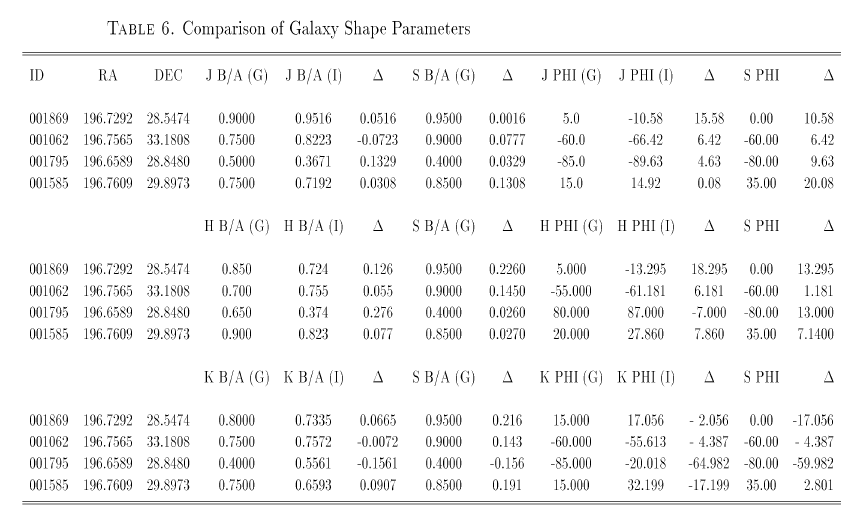Variable Ellipse Parameters
In the final section of the analysis we have allowed IRAF to select the galaxy center, the ellipticity, and the position angle (IRAF optimizes these parameters at each isophot) and have compared the results to the GALWORKS shape parameters and photometry. Table 6 shows the comparison of the ratio of semi-minor to semi-major axes (b/a) and position angle values between the GALWORKS the IRAF J, H, and K values, and the GALWORKS super-coadd values. The fourth and fifth columns in the table are the GALWORKS and IRAF b/a values in the J, H, or K filter and the sixth column is the difference between the two values. The seventh, eighth and ninth columns are the position angle values for GALWORKS and IRAF and the difference between the two. Columns ten and eleven are the super-coadd b/a and the difference between that and the IRAF value. The last 2 columns are the super-coadd values of the position angle and the difference between that and the IRAF value.

The table indicates that the differences between the b/a determinations are a few percent at J except for the case of the distorted galaxy 1795 where the error is 13%. The difference in the shape values for 1795 is not particularly surprising since elliptical parameters have decreased meaning for such a distorted galaxy. Table 6 also show different values for the super-coadd and their corresponding single-band b/a values. The difference is probably due to the fact that the b/a and p.a. values for the super coadd derive from an area further out from the core (since the noise is lower for the super, the 3*sigma contour is located beyond the individual 3-sigma contour); see for example, source 1869. It will be interesting to see whether this trend is borne out in the examination of a large amount of data.
The position angles from GALWORKS and IRAF are also shown in Table 6 in columns 9, 10 and 11 and the value for the super-coadd in column 12. If you disregard 1869 because of the difficultly in determining the position angle of such a circular galaxy, you can see that at J and H the agreement between the GALWORKS and the IRAf values are within a few degrees. It is important to note here that a few of the GALWORKS values are actually the position angle of the super-coadd because of the low signal-to-noise in the individual filter frame. For a detailed explination of when the super-coadd is used see Appendix C. For at least these few galaxies, the position angle agreement seems to be pretty good.



Next: Variable Elliptical Apertures: Up: Comparison of GALWORKS and Previous: Circular and Fixed
Tom Jarrett
Thu Feb 6 16:44:06 PST 1997